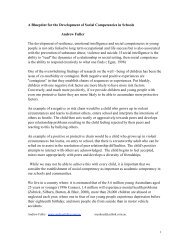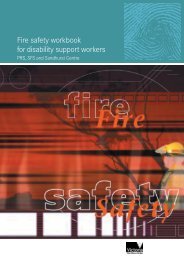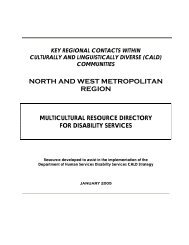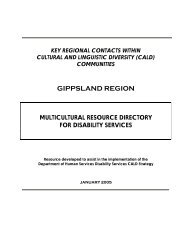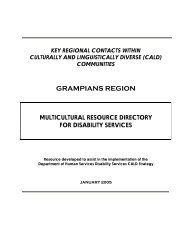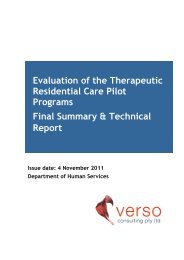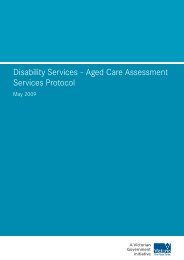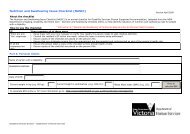Positive Behaviour Support - Department of Human Services - Vic ...
Positive Behaviour Support - Department of Human Services - Vic ...
Positive Behaviour Support - Department of Human Services - Vic ...
Create successful ePaper yourself
Turn your PDF publications into a flip-book with our unique Google optimized e-Paper software.
<strong>Positive</strong> behaviour support: Getting it right from the start - Facilitators reference manual 37<br />
5. Other senses such as smell should be used to interact with the person and provide them<br />
with information about their environment.<br />
6. Always provide verbal warnings (where needed) in conjunction with object symbols, raised<br />
symbols or touch cues, to warn the person about what is going to happen next.<br />
7. Always talk to the person and tell them what you are doing and what is happening.<br />
8. Be explicit in giving verbal directions to a blind person. Pointing or saying ‘over there’ is <strong>of</strong><br />
no help.<br />
9. If you notice a visually impaired person heading for danger, give the immediate short command<br />
to STOP. (Do not say ’watch out’, as they won’t know whether to stop, duck or back up.) Then<br />
explain the danger.<br />
10. If the person has trouble processing and understanding speech, use a range <strong>of</strong> tactile cues<br />
to assist the person. For example, if something is unique to you (such as a bracelet that you<br />
wear) introduce yourself and direct the person’s hand to your bracelet.<br />
General strategies to reduce sensory overload (including tactile defensiveness)<br />
1. Use a quiet calm voice.<br />
2. Set aside an uncluttered room where people can relax.<br />
3. Engage people in an activity that calms them (you may need a sensory assessment to<br />
find this out).<br />
4. Be aware that some people have their own calming techniques and are not trying to be<br />
difficult, e.g. sitting on the floor rather than climbing the stairs, taking empty packages<br />
out <strong>of</strong> the rubbish bin as they need something to scrunch to calm themselves<br />
5. Inform people when something that disturbs them is going to happen, e.g. bus arriving<br />
home, noise from maintain work, you are going to touch their hands to cut their nails.<br />
6. Help people to feel in control and if possible facilitate people to do thing for themselves<br />
7. Reduce noise levels in the room<br />
8. Reduce visual clutter, e.g. check to see that there are not too many pictures on the wall<br />
9. Use a firm touch rather than a light touch<br />
PowerPoint 57* For the person you have been developing a pr<strong>of</strong>ile on discuss the following areas and how<br />
they may impact on their daily routines and identify suitable strategies to use.<br />
• Hearing levels or ability<br />
• Visual ability<br />
• Tactile defensiveness issues<br />
Add this summary information to your client pr<strong>of</strong>ile.



